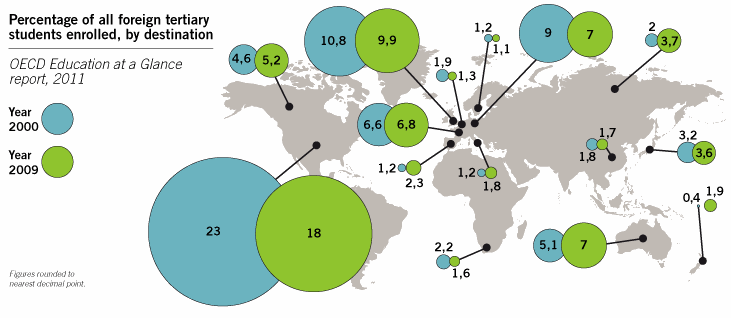However, according to Lawton, “US education is the most expensive in the world – but that was also the case when US share was not declining. Some nationalities may be more cost-sensitive than others but quality, and perception of quality, is just as important as cost.” That Australia, New Zealand, Japan and Korea all saw robust growth between 2000 and 2009 despite their high fees is further evidence that cost does not preclude growth if education is of a high enough standard.
News and business analysis for Professionals in International Education
Have some pie!
US market share 2000-2009: why the decline?

So what else has prevented the US growing in the way some of its peers have? Some say fault lies with national policy, or a lack thereof. Immigration rules are often singled out, with the 9/11 attacks an obvious turning point. While other countries relaxed their visa laws to aid recruitment, the US ushered in restrictive entry conditions that led to a 28% drop in international graduate applications in 2004 and 5% in 2005, according to the Council of Graduate Schools.
“During this period, US competitors increased their marketing efforts and relaxed their visa regulations to be more competitive. Australia benefited from a national international education plan that had all schools and government agencies working together toward a common goal – increasing international student numbers,” says Bill Colvin, Vice President of International Recruitment and Enrolment Services at MyGlobalEducation, a US-based lead generation site which helps international students find US university programmes.
The OECD report echoes this, contrasting the “pro-active marketing policies” of the Asia-Pacific region, which has treated internationalisation as part of broader trade strategy, with the “local and university-driven approach” pursued by the US, which has not had to rely on internationalisation for revenue thanks to years of strong domestic demand for HE.
Says Anderson: “The USA has never had large, centralised efforts to promote it as a destination for education or travel… There are more of these efforts in the last few years, but they are not as organised, nor are they as large – in relative terms – as what I’ve seen from the UK, Australia and New Zealand.”
Underlining this is the relatively low percentage of international students in US tertiary enrolments – just 3.5% in 2009, 15th highest among OECD countries and laps behind Australia (21.5%) and the UK (15.3%). In addition, just a “handful” of US universities recruit the lion’s share of international students, suggesting a huge amount of potential for growth.
The USA has never had large, centralised efforts to promote it as a destination for education or travel
Colvin blames this on a fragmented approach to internationalisation, with the confusion over the use of education agents – or the ethics regarding commission payments to them, more particularly – a case in point. “In addition, within the government, the Department of Commerce supports the use of agents, but the State Department does not. We have to get on the same page if we are going to regain market share, and that can only be done with a nationally cohesive plan,” he says.
The US does seem to have changed tack in recent years. It has just launched the Study in the States initiative which promises to review current policy in a bid to increase recruitment of the “brightest and best” science students from overseas. In addition, universities are increasingly setting up pathway programmes to boost recruitment, and visa conditions and exchange rates are more favourable than they have been for some time – all of which helped recruitment grow 3% to 690,923 in 2009/10 according to the IIE Open Doors report.
The scope for growth in international recruitment is considerable, and can be best exploited if a more concerted approach to internationalisation continues to be adopted. “The situation has greatly improved…,” claims Anderson, who says ELS as a company has seen record enrolments in three of the last four years. “Overseas the perception of higher education in the USA remains extremely high so if students perceive a good cost-value ratio and there is access via student visas, the USA will continue to be the top destination for international students.”
Still looking? Find by category:



3 Responses to US market share 2000-2009: why the decline?